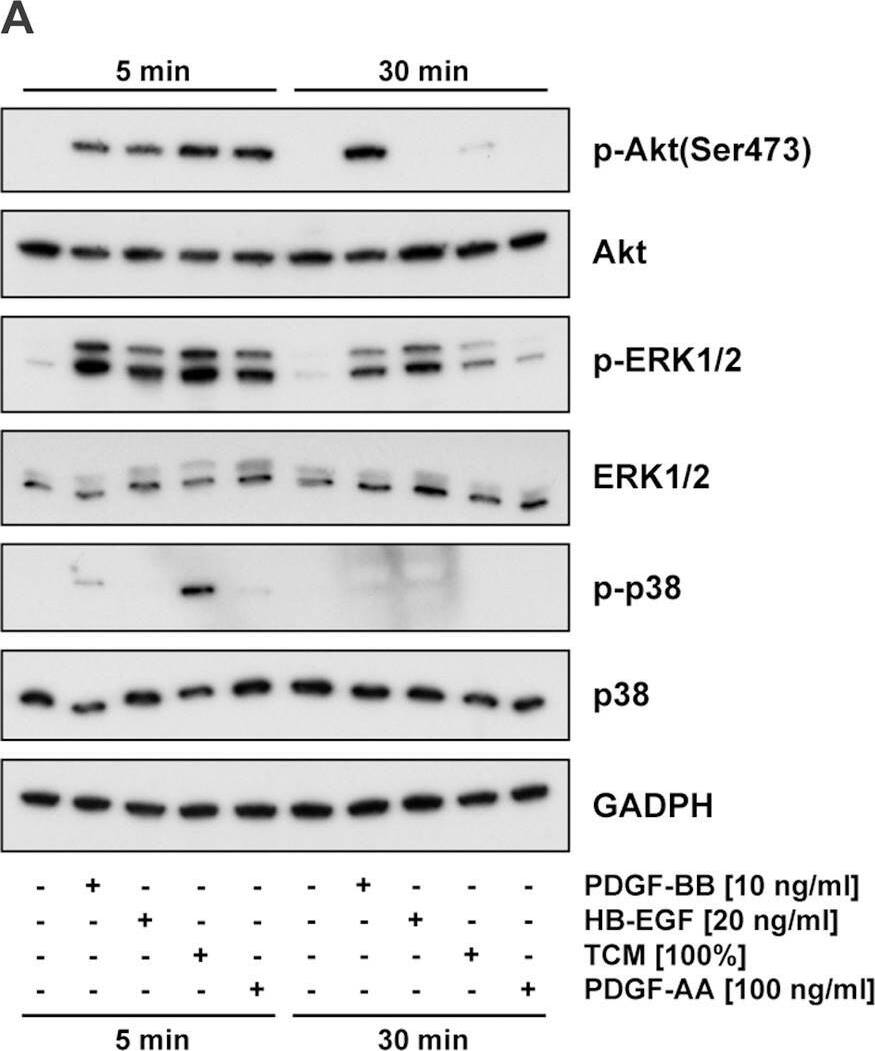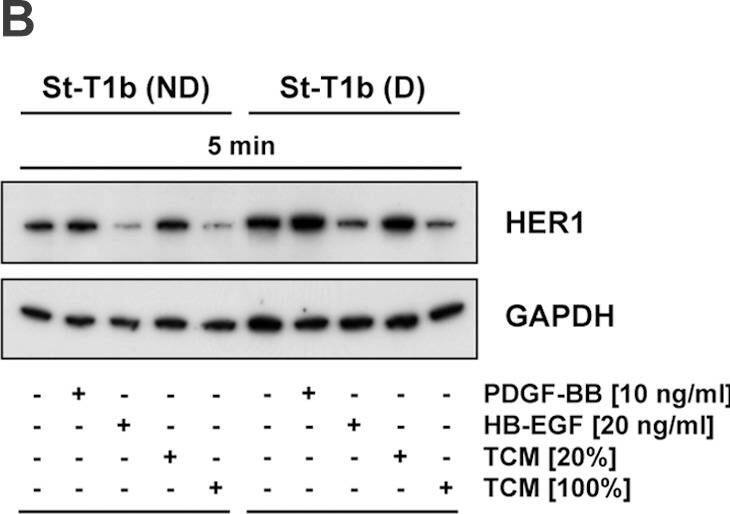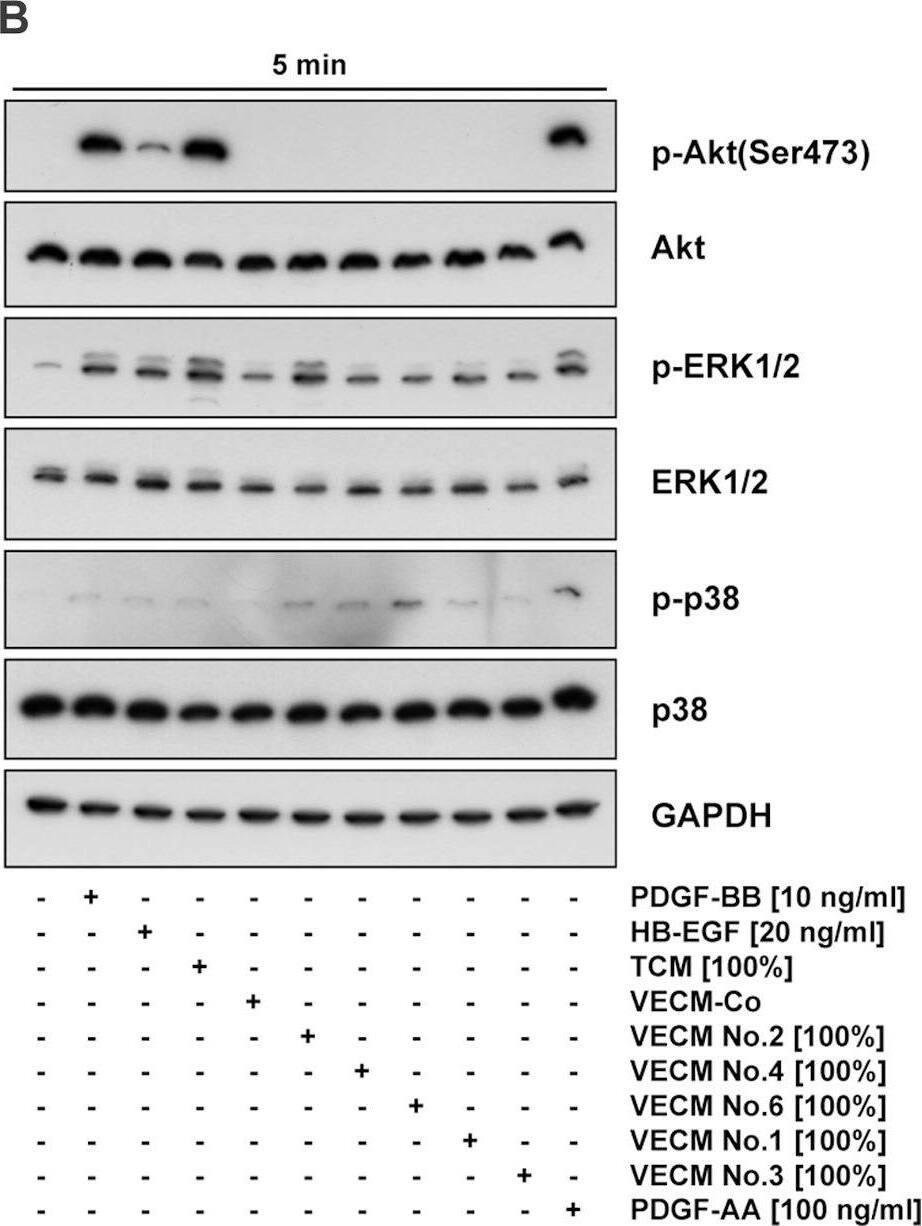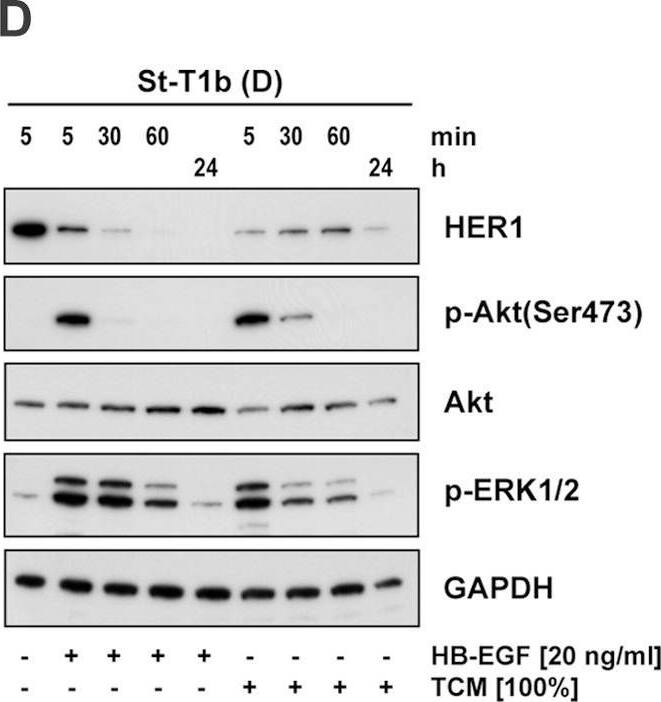Human HB-EGF Antibody
R&D Systems, part of Bio-Techne | Catalog # MAB2591

Key Product Details
Species Reactivity
Validated:
Cited:
Applications
Validated:
Cited:
Label
Antibody Source
Product Specifications
Immunogen
Asp63-Leu148
Accession # Q53H93
Specificity
Clonality
Host
Isotype
Endotoxin Level
Scientific Data Images for Human HB-EGF Antibody
Cell Proliferation Induced by HB-EGF and Neutralization by Human HB-EGF Antibody.
Recombinant Human HB-EGF (Catalog # 259-HE) stimulates proliferation in the Balb/3T3 mouse embryonic fibroblast cell line in a dose-dependent manner (orange line). Proliferation elicited by Recombinant Human HB-EGF (5 ng/mL) is neutralized (green line) by increasing concentrations of Human HB-EGF Monoclonal Antibody (Catalog # MAB2591). The ND50 is typically 0.5-2.5 µg/mL.Detection of HB-EGF by Western Blot
Signaling pathways activated by PDGF-AA, PDGF-BB, HB-EGF, TCM, or VECM.(A) Decidualized St-T1b were starved in Opti-MEM and then treated for 5 or 30 min with PDGF-BB, HB-EGF, TCM or PDGF-AA. Levels of phosphorylated (p-) or total ERK1/2, Akt, and p38 were determined by Western blotting. (B) Decidualized hESC were starved in Opti-MEM and then treated for 5 min with PDGF-BB, HB-EGF, TCM, 5 individual VECM preparations, villous explant control medium (VECM-Co), or PDGF-AA. Western blotting was performed as above. Image collected and cropped by CiteAb from the following open publication (https://pubmed.ncbi.nlm.nih.gov/23349855), licensed under a CC-BY license. Not internally tested by R&D Systems.Detection of HB-EGF by Western Blot
Expression and regulation of HER1 in St-T1b cells and hESCs.(A) Effect of decidualization on HER1 expression. Whole cell extracts from two individual hESC preparations or from St-T1b cells, non-decidualized (−) or decidualized (+), were immunoblotted for HER1 (antibody from New England Biolabs), and for GAPDH as a loading control. In addition, the levels of Nur77, alpha-SMA, MLC2 and phospho-MLC2 were analyzed. (B, C, D) Time-dependent downregulation of HER1 in response to HB-EGF or TCM. Non-decidualized (ND) or decidualized (D) St-T1b cells, maintained in Opti-MEM, were incubated with PDGF-BB, HB-EGF or TCM (20 or 100%) for 5 min (B) or 5, 30 and 60 min (C) and subjected to Western Blot analysis for HER1 (antibody from Santa Cruz). Decidualized St-T1b cells were stimulated with HB-EGF or TCM (100%) for 5, 30 and 60 min or 24 h (D) and analyzed for HER1 by Western blotting (antibody from Santa Cruz), followed by immunoblotting for phospho-ERK1/2 and phosphorylated (Ser473) and total Akt. Image collected and cropped by CiteAb from the following open publication (https://pubmed.ncbi.nlm.nih.gov/23349855), licensed under a CC-BY license. Not internally tested by R&D Systems.Applications for Human HB-EGF Antibody
Western Blot
Sample: Recombinant Human HB-EGF (Catalog # 259-HE)
Neutralization
Formulation, Preparation, and Storage
Purification
Reconstitution
Formulation
Shipping
Stability & Storage
- 12 months from date of receipt, -20 to -70 °C as supplied.
- 1 month, 2 to 8 °C under sterile conditions after reconstitution.
- 6 months, -20 to -70 °C under sterile conditions after reconstitution.
Background: HB-EGF
HB-EGF was originally purified based on its heparin-binding property and mitogenic activity on BALB-3T3 fibroblasts from the conditioned medium of the human U-937 histiocytic lymphoma cell line. The natural protein has an apparent molecular mass of 19-23 kDa and exists in multiple forms as a result of heterogenous O‑glycosylation and/or N-terminal truncation. In addition to fibroblasts, HB-EGF is also a potent mitogen for keratinocytes and smooth muscle cells but not for capillary endothelial cells. HB-EGF is produced in monocytes and macrophages. In addition, transcription of HB-EGF can be induced in vascular endothelial cells as well as aortic smooth muscle cells (SMC), suggesting that HB-EGF may have an important role in the pathogenesis of atherosclerosis.
HB-EGF is a member of the EGF family of mitogens which also include transforming growth factor-alpha (TGF-alpha), amphiregulin (AR), rat schwanoma-derived growth factor (SDGF), vaccinia growth factor (VGF), and the various ligands for the Her2/ErbB2/Neu receptor. All these cytokines are derived from transmembrane precursors that contain one or several EGF structural units in their extracellular domain. Many of these transmembrane precursors are biologically active and seem to play a role in juxtacrine stimulation of adjacent cells. The cDNA for HB-EGF encodes a 204 amino acid residue transmembrane protein that is proteolytically cleaved to generate the soluble HB-EGF. Like EGF, TGF-alpha, and AR; HB-EGF binds to the EGF receptor and activates the receptor tyrosine kinase. HB-EGF is reported to be a more potent SMC mitogen than EGF. It has been suggested that the differential activities found for HB-EGF compared to EGF may be mediated by the heparin-binding properties of HB-EGF. A diphtheria toxin receptor that mediates the endocytosis of the bound toxin has been cloned and found to be identical to the transmembrane HB-EGF precursor.
Long Name
Alternate Names
Gene Symbol
UniProt
Additional HB-EGF Products
Product Documents for Human HB-EGF Antibody
Product Specific Notices for Human HB-EGF Antibody
For research use only




